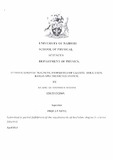| dc.description.abstract | Investigation of magnetic properties of granite rock using Raman spectrometer.
Laser Raman spectroscopy has been proposed for the purpose of definitive mineralogy including
mineral identification, mineral proportion (grains making up the minerals), the size of the grains
and the spectroscopic behavior of individual grains.
In this project, Raman spectrometer with a green laser was used to identify various types of
grains which were present in the six samples previously collected from various parts of Kenya.
Also their respective coercivity was determined by relating the previously obtained coercivity
with the Raman spectra. The coercivity curve explains the strength of the paleomagnetism
present in the samples. The wavelength of the green silicon-laser used was 532nm, the size of
each grain was determined using the Raman spectrometer.
There are various factors which naturally acquired magnetism in minerals depends on namely:
the size of the grain, the shape of the grain, the field strength of the earth, and the presence of
impurities and dislocations in minerals. If the grains ofthe magnetic materials are large,
magnetism acquired is weak and unstable. If grains are small, less than lOJJm,the magnetism
acquired is stable and hard. | en_US |

